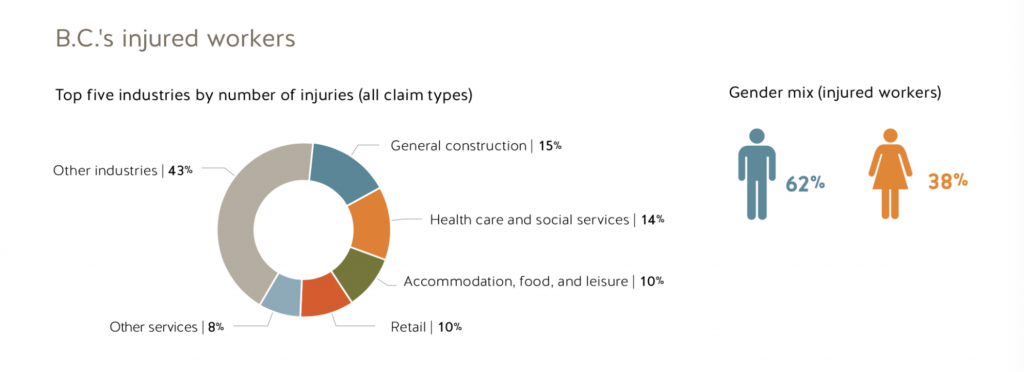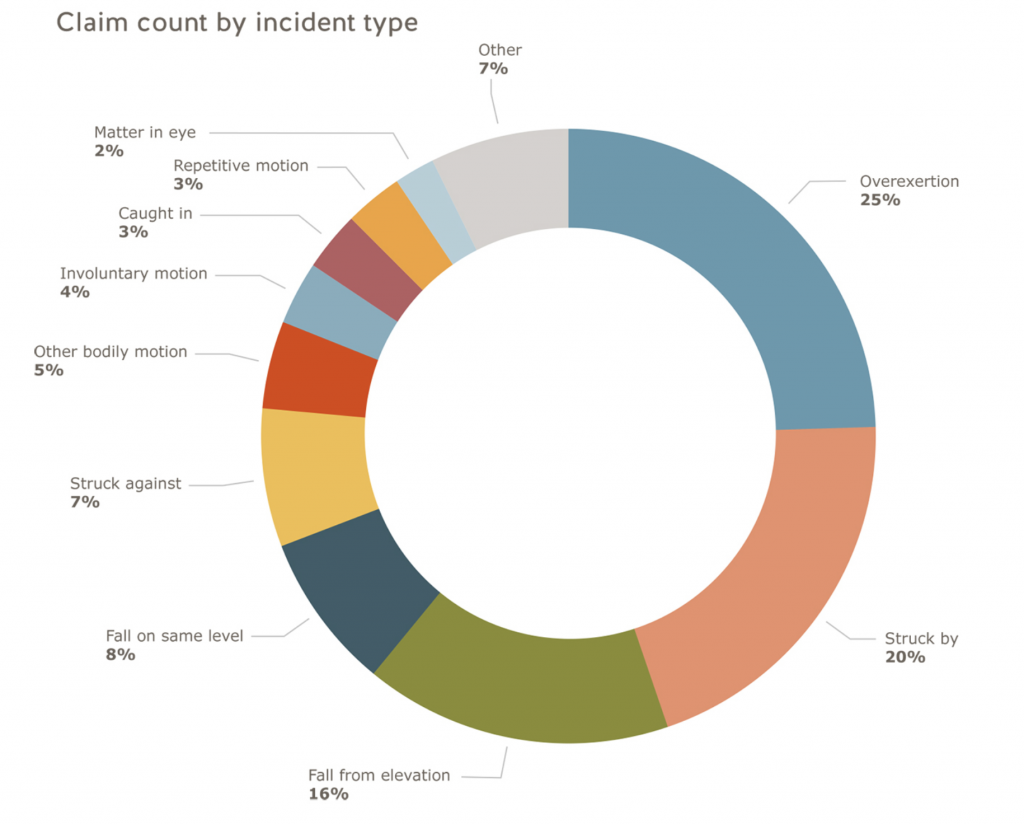Learn the five most common injuries on BC construction worksites so you can help protect yourself and those around you.
The construction industry accounts for the highest number of work-related injuries and fatalities in British Columbia. In light of this troubling statistic, our aim is to shed the light on the most common injuries encountered on worksites, in hopes of drawing attention to these common hazards so that employers can make strategic plans to mitigate these risks and ensure employee safety.

The Most Common Injuries on Construction Sites
From 2014 to 2018 WorkSafe BC reported overexertion, struck by, fall from elevation, fall on the same level, and struck against as the five most common workplace injuries. A complete list of injuries is depicted in the graph below.

Details of the five most common workplace injuries are outlined below in further detail.
Overexertion (25%)
Overexertion is the leading cause of workplace injury. For those working on construction sites, this statistic comes at no surprise. With long hours and physically demanding work, employees are constantly faced with situations that push their physical limits.
A main cause attributed to overexertion is when employees perform excessively physical activities that push the limits of their capabilities, such as heavy lifting, reaching, and using excessive force. There are significant health consequences associated with overexertion. These include ergonomic injuries, including soft tissue damage, specifically of the muscles, nerves, tendons, ligaments, joints, cartilage, blood vessels and spinal discs.
Struck By (20%)
The second leading workplace injury results from employees being struck by objects and equipment. This includes tools, machinery (both stationary and mobile), equipment, and other hazards.
Employees on construction sites are constantly at risk for being struck by objects that are flying, rolling, falling, or swinging. These types of incidents can be life threatening, depending on the power and force behind the object that strikes the employee. To help mitigate this hazard, it’s important to secure equipment, tools, and other objects to ensure they don’t accidentally come loose. This could include using chock blocks on parked equipment or replacing tools back in secure storage facilities once they are no longer needed.
Fall From Elevation (16%)
It’s hard to find a construction site that doesn’t require workers to work from heights at least some of the time. From scaffolding to ladders, working at heights comes part and parcel with most worksites. Because of this, falls from elevations are the third most common workplace injury in BC.
Falls from elevations can result in bruises, scrapes, lacerations, and broken bones. In worse case scenarios, they can result in severe head trauma, brain injury, internal injuries, or even death. Because of the significant risks associated with falls from elevations, employers need to take this hazard seriously and implement strong internal processes and procedures to help mitigate this significant danger.
Fall protection and fall arrest training are useful resources to help workers become familiar with the hazards associated with working at heights. Properly installed guardrails and fall restraints are also important. Be sure to check with your local health and safety authority to ensure your workplace is following all the necessary procedures to prevent a fall on your site.
Fall On The Same Level (8%)
The majority of injuries occur on the working surface (19%), with 67% of cases resulting from slips and trips. Many of these injuries can be prevented with good housekeeping, proper footwear, and due diligence.
According to the Canadian Centre for Occupational Health and Safety (CCOHS), slips happen where there is not enough friction between a person’s footwear and the working surface. Common causes of slips include:
- Wet or oily surfaces
- Occasional spills
- Weather hazards
- Loose, unanchored rugs or mats
- Flooring or other walking surfaces that do not have same degree of traction in all areas
On the other hand, trips occur when a person’s foot collides with an object causing that person to lose their balance. CCOHS sites the following situations as common causes of tripping:
- Obstructed view
- Poor lighting
- Clutter in the way
- Wrinkled carpeting
- Uncovered cables
- Bottom drawers not being closed
- Uneven steps and walking surfaces
Struck Against (7%)
Workers experience struck against injuries when they come into contact with a moving or stationary object or person. Struck against injuries can occur when a worker is pinned against an object, or involuntarily held in place by force. These incidents may result in small sprains, broken bones, fractures, as well as elbow, shoulder, hip, knee, and ankle injuries. In a worst case scenario, struck against injuries may result in head and brain injuries.
To mitigate this hazard, ensure employees are free from loose and baggy clothing that can get caught on moving pieces. It’s also important for employees to be mindful of where they position their body in relation to objects and equipment. For example, it is standard practice across most worksites to walk in front of equipment to help avoid getting struck against a moving vehicle.
General Guidelines to Prevent Common Accidents
High risk worksites, such as construction sites, are always filled with hazards. Some hazards are easy to identify and some are not. All injuries are preventable, and workers and employers alike should work to achieve a zero injury mindset.
Some tips to help reduce workplace injuries include:
- Provide staff with emergency training
- Provide proper PPE and make proper PPE mandatory on site
- Regular site and equipment inspections, followed up with the removal of identified hazards
- Awareness and training for proper lifting techniques
- A team mentality that helps and supports each other
Understanding the top workplace injuries in BC helps workers to better understand the risks associated with their worksite. Construction sites are filled with hazards, and it’s up to each employee to advocate for their own safety.

